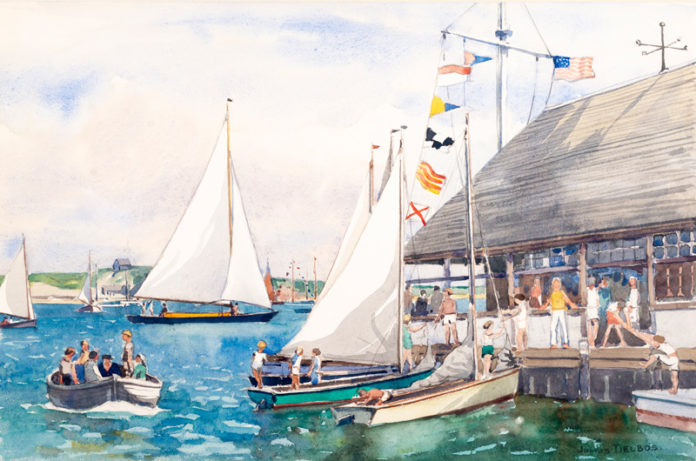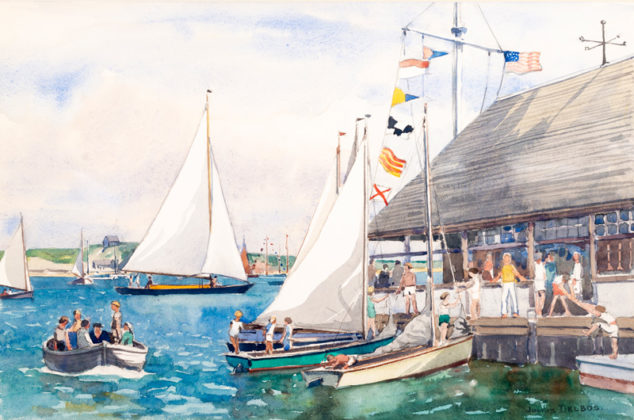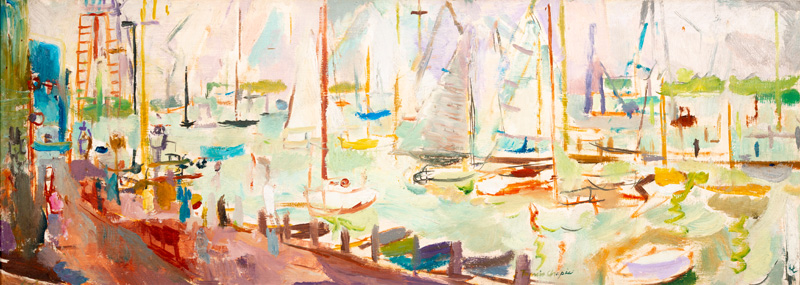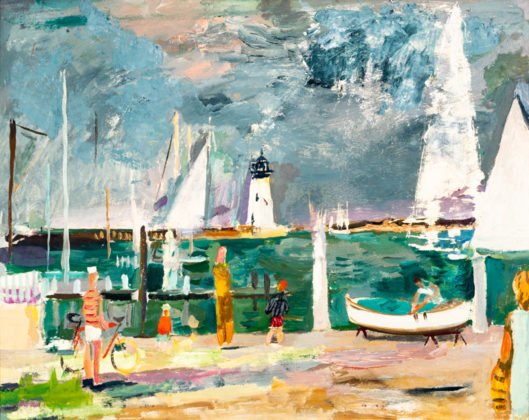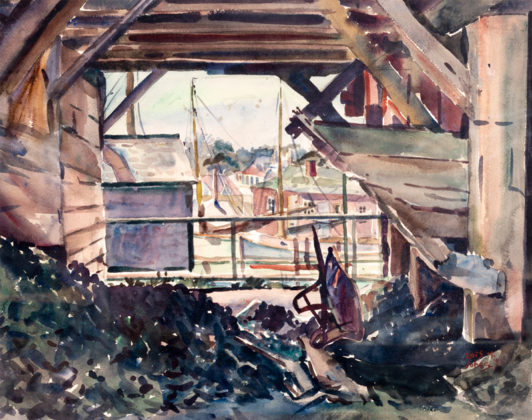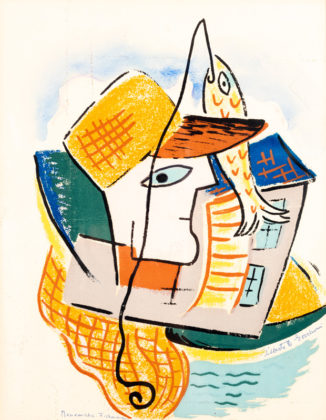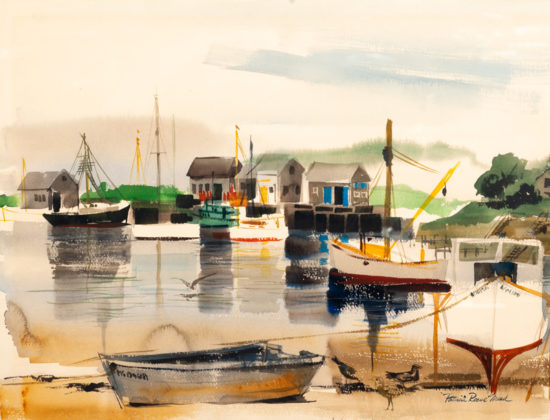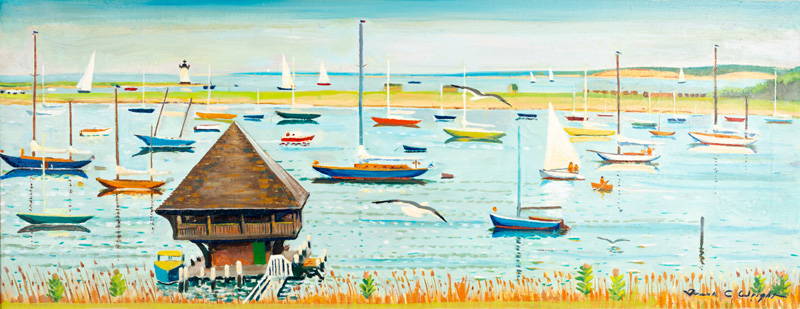You may think that art museums — like concert halls and opera houses — are things you won’t find on the Vineyard. But you’d be wrong. The Island actually has two different venues that host rotating exhibits by esteemed local artists and others who have made a name for themselves beyond our shores.
Currently the Martha’s Vineyard Museum is hosting an exhibition by the late Stan Murphy, while over at the Carnegie Heritage Center in Edgartown, one can view over a dozen works by artists who painted on the Vineyard from the 1950s to the 1970s and whose work can be found in the permanent collections of the Metropolitan Museum, the Smithsonian, and elsewhere.
The museum’s exhibit, which will hang through August 21, is titled “Stan Murphy at 100,” to reflect the age the popular Island artist would be had he not passed away in 2003. Included in the show, which takes up about half of the second floor, are paintings, drawings, studies for paintings, and some of Murphy’s sketchbooks, providing a comprehensive retrospective of the late artist’s career.
Murphy relocated to Martha’s Vineyard in 1948 after serving in the military during WWII and then attending the famed Art Students League in New York City and working as an illustrator for various publications such as “Colliers” and “The New Yorker.”
During his 50-plus years on the Island he earned his well-deserved reputation as a master of his craft for his landscape paintings and, especially, his iconic oils of local farmers, fishermen, and other salt-of-the-earth types.
Murphy was a beloved Island figure who sold his work in a small studio/gallery he built himself in West Tisbury. He also painted a series of four large-scale murals to adorn the walls of the Katharine Cornell Theater in Vineyard Haven. These remarkable works of art, showing various sides of life on the Vineyard, are still on view today.
Murphy became close friends with the famed Regionalist painter Thomas Hart Benton, who spent many summers in Chilmark. Benton encouraged Murphy at a time when the latter was just establishing himself as a portraitist.
However, it was Murphy’s association with local tradespeople that had a powerful influence on the work that he has become most associated with — portraits of sturdy, weather-worn men plying their various trades. His style is very distinctive, placing equal emphasis on his subject’s various activities and locations as on the subjects themselves, showing the men as an integral part of the Island landscape.
The museum’s decision to hang the exhibit was informed partially by Murphy’s close association with the institution (then located in Edgartown and called the Martha’s Vineyard Historical Society). As a member of the Governing Council, he spent a great deal of time studying whaling logbooks, old illustrations and other artifacts, drawing inspiration for his work. Murphy developed a particular interest in the museum’s impressive collection of duck decoys and he eventually wrote a book titled “Martha’s Vineyard Decoys.”
Of the exhibit, co-curator Anna Barber says, “It’s almost a biography of our Island at a point when the Vineyard was changing dramatically. He captured a way of life that is no longer.”
Over at the Carnegie in Edgartown, works by some of America’s preeminent artists of the mid-20th century will be on display throughout the fall. The exhibit represents a selection of works from the permanent collection of the Martha’s Vineyard Art Association (MVAA). Although the 70-year-old organization hangs a sample of works from this collection every year at their home base, the Old Sculpin Gallery, this exhibit will mark the first time that some of the MVAA’s most outstanding archival paintings will be available for view by the public for an extended period of time.
“The work is usually up for just a week at the Old Sculpin,” says MVAA board co-president Melinda Fager. “It’s really nice to have a continuous exhibit.”
Meg Mercier, the other co-president adds, “A lot of the pieces represent our most famous artists.” That’s no exaggeration. Among the works on display are paintings by Vaclav Vytlacil who has been ranked among the top modernist artists along with Pablo Picasso and Henri Matisse; Lois Mailou Jones, one of the preeminent Black artists of the 1950s and 60s whose work is included in the permanent collection of the Metropolitan Museum, the Smithsonian, and the National Portrait Gallery, and Francis Chapin, whose work is also part of the Metropolitan Museum’s collection and who served as artist-in-residence at the Old Sculpin for many years.
“It’s just a very precious part of Edgartown and Vineyard history,” says Rosalie Ripaldi Shane, who has lovingly served as curator of the collection for many years — maintaining, repairing and overseeing storage of the 130 plus paintings. “The pieces that were picked for the exhibit are very prominent in the collection.”
The MVAA and the Old Sculpin Gallery play a big role in the Vineyard’s history. The organization was incorporated in 1954 with a mission “to increase facilities of art education, create interest in the arts, make an art center for the whole island, establish a permanent collection, and preserve an old landmark.” The post-and-beam building that houses the gallery was built in 1840 and served variously as a sail loft, a granary, and a boatbuilding shop before being transformed into a home for the MVAA in 1953. As well as serving as a gallery, the facility hosts art classes for children and serves as studio space for members.
Visitors can check out the art collection at the Carnegie and then hop over to the Old Sculpin Gallery (located just minutes away) to view work by the current members.

